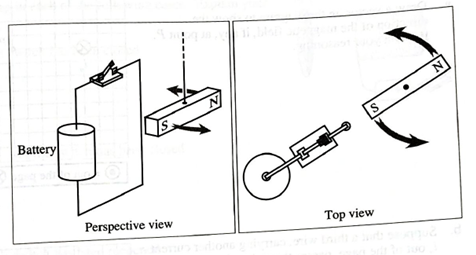
Concept explainers
A magnet is hung by a string and then placed near a wire as shown. When the switch is closed, the magnet rotates such that the ends of the magnet move as indicated by the arrows.
At instant the switch is closed determine:
- the direction of the current through the wire segment nearest the magnet. Explain.

The direction of the current through the wire segment nearest to the magnet and direction of the net force exerted by the magnet on the wire segment at the instant when the magnet is in its normal position with their explanation.
Explanation of Solution
Introduction:
According to Fleming’s right-hand rule, the first finger, second finger and thumb are held at a right angle to each other, then the forefinger will represent the direction of the line of force. The thumb will point the direction of the motion and the second finger will give the direction of the induced current.
The expression of the magnetic force is given by the following expression,
Here,
Case-1
When the switch is closed, the magnetic north of the magnet moves towards the circuit which implies that the induced current in the wire tends to deflect the magnet towards the right side. With the application of Fleming’s right hand, the anti-clockwise current can produce the magnetic field which is opposite to the magnetic south of the magnet and the direction of the induced current will be in the upward direction. The direction of the current and the magnetic field is shown in Figure 1.

Figure 1
Consider the direction of the current represented by the

Figure 2
This implies that the direction of the force acting on the wire segment is towards the right.
Conclusion:
Therefore, the direction of the current through the segment near the magnet is up and the direction of the current in the wire is anticlockwise and the direction of the force acting on the wire segment is towards the right.
Want to see more full solutions like this?
Chapter 21 Solutions
Tutorials In Introductory Physics: Homework
Additional Science Textbook Solutions
Organic Chemistry (8th Edition)
Introductory Chemistry (6th Edition)
College Physics: A Strategic Approach (3rd Edition)
Human Biology: Concepts and Current Issues (8th Edition)
Genetic Analysis: An Integrated Approach (3rd Edition)
Campbell Essential Biology (7th Edition)
- 2. Consider the situation described in problem 1 where light emerges horizontally from ground level. Take k = 0.0020 m' and no = 1.0001 and find at which horizontal distance, x, the ray reaches a height of y = 1.5 m.arrow_forward2-3. Consider the situation of the reflection of a pulse at the interface of two string described in the previous problem. In addition to the net disturbances being equal at the junction, the slope of the net disturbances must also be equal at the junction at all times. Given that p1 = 4.0 g/m, H2 = 9.0 g/m and Aj = 0.50 cm find 2. A, (Answer: -0.10 cm) and 3. Ay. (Answer: 0.40 cm)please I need to show all work step by step problems 2 and 3arrow_forwardFrom number 2 and 3 I just want to show all problems step by step please do not short cut look for formulaarrow_forward
- Look at the answer and please show all work step by steparrow_forward3. As a woman, who's eyes are h = 1.5 m above the ground, looks down the road sees a tree with height H = 9.0 m. Below the tree is what appears to be a reflection of the tree. The observation of this apparent reflection gives the illusion of water on the roadway. This effect is commonly called a mirage. Use the results of questions 1 and 2 and the principle of ray reversibility to analyze the diagram below. Assume that light leaving the top of the tree bends toward the horizontal until it just grazes ground level. After that, the ray bends upward eventually reaching the woman's eyes. The woman interprets this incoming light as if it came from an image of the tree. Determine the size, H', of the image. (Answer 8.8 m) please show all work step by steparrow_forwardNo chatgpt pls will upvotearrow_forward

 Physics for Scientists and Engineers: Foundations...PhysicsISBN:9781133939146Author:Katz, Debora M.Publisher:Cengage Learning
Physics for Scientists and Engineers: Foundations...PhysicsISBN:9781133939146Author:Katz, Debora M.Publisher:Cengage Learning Principles of Physics: A Calculus-Based TextPhysicsISBN:9781133104261Author:Raymond A. Serway, John W. JewettPublisher:Cengage Learning
Principles of Physics: A Calculus-Based TextPhysicsISBN:9781133104261Author:Raymond A. Serway, John W. JewettPublisher:Cengage Learning Glencoe Physics: Principles and Problems, Student...PhysicsISBN:9780078807213Author:Paul W. ZitzewitzPublisher:Glencoe/McGraw-Hill
Glencoe Physics: Principles and Problems, Student...PhysicsISBN:9780078807213Author:Paul W. ZitzewitzPublisher:Glencoe/McGraw-Hill College PhysicsPhysicsISBN:9781938168000Author:Paul Peter Urone, Roger HinrichsPublisher:OpenStax College
College PhysicsPhysicsISBN:9781938168000Author:Paul Peter Urone, Roger HinrichsPublisher:OpenStax College Physics for Scientists and Engineers, Technology ...PhysicsISBN:9781305116399Author:Raymond A. Serway, John W. JewettPublisher:Cengage Learning
Physics for Scientists and Engineers, Technology ...PhysicsISBN:9781305116399Author:Raymond A. Serway, John W. JewettPublisher:Cengage Learning





